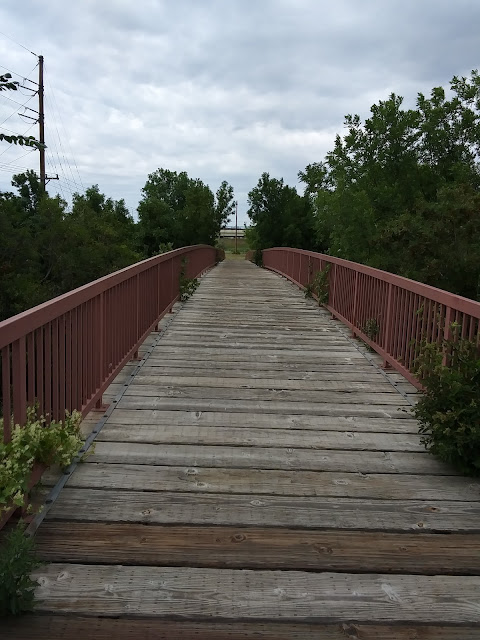The Lost Mower of Hay Creek
 |
| Just beyond the power pole, between the near and far pole sits an old Adriance, Platt and Company horse drawn sickle mower. Just a few years ago, it was still visible from the bridge. |
In the early 2000's the Hay Creek Trail was put in next to the Pebble Creek Golf Course built a few years earlier. I remember it being hay land, hence the name Hay Creek. When it was first put in, the bottom land along the creek was mostly grassland. I have been hiking and biking this trail since it was first installed and it has been interesting to watch its evolution, as trees and bushes have increasingly colonized the creek side. For years after the trail was put in, I could walk the creek side to get a close up look at the plants and animals, but also to pluck dozens of errant golf balls lodged in the tall grass and cattails along the bank.
Every time I return to Bismarck, if the weather is nice enough, I hike one of the regional trails. In the over two decades I have been living in and visiting Bismarck, I have watched the evolution of a regional trail system that gets better and better. Returning to these trails after years of absence allows me to reflect on the changes that have taken place. In August of 2022, I visited the Hay Creek trail. Where not to many years ago, I could go off trail and walk the bank of the creek for much of its length, in many of those places, brush now covers the banks.
 |
| Just south of Century Avenue one used to be able to see the mower from the deck of the second bridge. |
Just south of Century Avenue, is a short section where three bridges cross the winding course of the creek. Bounded by Pebble Creek Golf Course to the west and a railroad line to the east, sits my favorite section of the five plus mile trail. It is an area where I always stop to linger at each bridge crossing to gaze into the waters and at the changing palette of flora along its banks. From the first time I hiked or biked it when it was first built, I spied the carcass of a broken down old horse drawn mower sitting on a peninsula a few dozen yards to the west of the deck of he second bridge pictured above.
 |
| Just a few years ago it wasn't yet overgrown. |
A
An elegant Art Nouveau gearbox that according to old timer, the unsealed type wore down the gears.
 |
| An original Buckeye mower from the Adriance & Platt works in N.Y. |
It used to be easy to jump over the railing and down the five or six feet to the ground and walk over to check out the old mower. Old machinery along the trail always adds spice to any hike. There is something fascinating about the ruins of old machines existing in the landscape, slowly blending in with it as their solid materials become part of their surroundings. Across the plains, if you see an old horse drawn mower with its meter diameter cast iron wheels and organically formed Art Nouveau steel typical of the turn of the 19th to the 20th century, it is usually a McCormick and of those, usually a number 9. I have an old unrestored number 9 that I once wanted to bring back into mowing trim, but now have imaginings of making it into a steam punk hoverboard or fun pretend laser cannon platform.
The one siting in Hay Creek I identified as an Adriance, Platt and Company mower, a truly rare beast that might have been sitting there for the better part of the last century as the company sold out to Moline Plow Company in 1913. My love of restored machines tends toward saving and restoring it or seeing that someone does, while my aesthetic self feels it is a fitting homage to the brief agricultural past of the fittingly named Hay Creek and its durable bones should sit there for decades to come to be enjoyed by intrepid explorers like me who choose to jump the fence and get off the trail.
A rare model 8 like the one in Hay Creek sporting the distinctive Art Nouveau gearbox by the left wheel. Wise old mechanics told me the open gear box with those decorative holes collected dirt that wore the gears down. Many probably ended up in scrap drives during the world wars (another favorite topic of mine). A truly rare mower on the western plains. Should it be restored in a museum, or left as a now virtually hidden artifact near the Hay Creek trail? Photo from Yesterday's Tractors



Comments